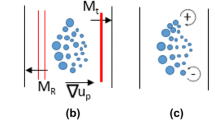Abstract
Numerical modeling of the interaction between a cloud of water droplets and a planar shock wave is compared with experimental data. The mathematical model relies on an Eulerian description of the dispersed phase with the assumption of dilute flows. It is shown that the secondary atomization of the droplets strongly influences the structure of both the shock wave and the induced flow. After shock loading, the individual liquid components generate daughter droplets, and the overall interphase surface per unit volume undergoes strong variations which modify the pressure relaxation process towards a dynamic and thermal equilibrium state. The experimental data enable one to determine the best analytical formulation of the droplet number production rate. Models of droplet number production rate are compared in order to highlight this feature. The model based on the assumption of linear variation of droplet diameter with time gives the best agreement between the numerical results and the experimental data.














Similar content being viewed by others
References
Carrier, G.F.: Shock waves in a dusty gas. J. Fluid Mech. 4, 376–385 (1958)
Marble, F.E.: Dynamics of a gas containing small solid particles. Comb. Propuls. Fifth AGARD Colloq. 7, 175–213 (1963)
Rudinger, G.: Some properties of shock relaxation in gas flows carrying small particles. Phys. Fluids 7, 658–663 (1964)
Sommerfeld, M.: The unsteadiness of shock waves propagating through gas-particle mixtures. Exp. Fluids 3, 197–206 (1985)
Outa, E., Tajima, K., Morii, H.: Experiments and analyses on shock waves propagating through a gas-particle mixture. Bull. Jpn. Soc. Mech. Eng. 19(130), 384–394 (1976)
Chauvin, A., Jourdan, G., Daniel, E., Houas, L., Tosello, R.: Experimental investigation of the propagation of a planar shock wave through a two-phase gas-liquid medium. Phys. Fluids 23, 113301 (2011)
Kolev, N.I.: Multiphase Flow Dynamics 2. Mechanical and Thermal Interactions, Springer, 2 (2002)
Verhagean, J.: Modélisation multiphasique d’écoulements et de phénomènes de dispersion issus d’explosion (2011), PhD manuscript, Aix-Marseille University, France
Tyler, E.: Instability of liquid jets. Philos. Magazine Series 7 16(105), 504–518 (1933)
Jourdan, G., Daniel, E., Houas, L., Tosello, R.: Attenuation of a shock wave passing through a cloud of water droplets. Shock Waves 20, 285–296 (2010)
Daniel, E., Saurel, R., Loraud, J.C., Larini, M.: A multiphase formulation for two phase flows. Int. J. Num. Methods Fluid Flows 4, 269–280 (1994)
Saurel, R., Daniel, E., Loraud, J.C.: Two phase flows: second order schemes and boundary conditions. AIAA J. 32(6), 1214–1221 (1994)
Gelfand, B.E.: Droplet breakup phenomena in flows with velocity lag. Prog. Energy. Combust. Sci. 22, 201–265 (1996)
Jourdan, G., Houas, L., Igra, O., Estivalezes, J.L., Devals, C., Meshkov, E.E.: Drag coefficient of a sphere in a non-stationary flow: new results. Proc. R. Soc. A 463(2088), 3323–3345 (2007)
Ranz, W.E., Marshall, W.R.: Spray simulation—evaporation from drop. Chem. Eng. Prog. 48, 141–173 (1952)
Thevand, N., Daniel, E., Loraud, J.C.: On high resolution schemes for compressible viscous two-phase dilute flows. Int. J. Numer. Meth. Fluids 31, 681–702 (1999)
Weber, C.: Zum zerfall eines flüssigkeitsstrahles. Z. Angew. Math. Mech. 11, 136–154 (1931)
Guildenbecher, D.R., Lopez-Rivera, C., Sojka, P.E.: Secondary atomization. Exp. Fluids 46, 371–402 (2009)
Hsiang, L.P., Faeth, G.M.: Drop deformation and breakup due to shock wave and steady disturbances. Int. J. Multiph. Flow 21, 545–560 (1995)
Zeoli, N., Gu, S.: Numerical modelling of droplet break-up for gas atomization. Comput. Mat. Sci. 38(2), 282–292 (2006)
Utheza, F., Saurel, R., Daniel, E., Loraud, J.C.: Multiphase flow dynamics 2. Droplet break-up through an oblique shock wave. Shock Waves 5, 265–273 (1996)
Brodkey, R.S.: The Phenomena of Fluid Motions. Addison-Wesley, Reading Mass (1967)
Hsiang, L.P., Faeth, G.M.: Near-limit drop deformation and secondary breakup. Int. J. Multiph. Flow 18, 635–652 (1992)
Ranger, A.A., Nicholls, J.A.: Aerodynamic shattering of liquid drops. AIAA 7, 285–290 (1969)
Pilch, M., Erdman, C.A.: Use of break-up time data to predict the maximum size of stable fragment for acceleration induced breakup of a liquid drop. Int. J. Multiph. Flow 16, 741–757 (1987)
Nigmatulin, R.I.: Dynamics of Multiphase Media. Hemisphere Publishing Company, New york (1991)
Joseph, D.D., Belanger, J., Beavers, G.S.: Breakup of a liquid drop suddenly exposed to a high-speed airstream. Int. J. Multiph. Flow 25, 1263–1303 (1999)
Chauvin, A., Jourdan, G., Daniel, E., Houas, L., Tosello, R.: Study of the interaction between a shock wave and a cloud of droplets, 28th International Symposium on Shock Waves, 2, 39-44, Springer Berlin Heidelberg (2012)
Del Prete, E., Haas, J.-F., Chauvin, A., Jourdan, G., Chinnayya, A., Hadjadj, A.: Secondary atomization on two-phase shock wave structure, 28th International Symposium on Shock Waves, 2, 95-100, Springer Berlin Heidelberg (2012)
Wierzba, A., Takayama, K.: Experimental investigation of the aerodynamic breakup of liquid drops. AIAA J. 26, 1329–1335 (1988)
Acknowledgments
The authors would like to thank DGA-Tn for supporting this study and Robert Tosello for valuable discussions.
Author information
Authors and Affiliations
Corresponding author
Additional information
Communicated by A. Hadjadj.
Appendix
Appendix
Although the numerical method is detailed in [16], it is important for this specific unsteady application to verify the grid independence of the solutions. Various meshes are tested on the simulations presented in Sect. 7. Mesh 1 corresponds to the one used in the present study (\(\mathrm{d}x =1\) mm), the cell is then divided by two (Mesh 2), and the third mesh \(\mathrm{d}x = 0.25\) mm (Mesh 3). The pressure evolution along the shock tube axis is plotted at time \(t=4.5\) ms for these different meshes. This pressure evolution shows that each wave pattern (expansion fan, shock wave, interaction with the droplet cloud) is computed in the same way regardless of the mesh used. The differences are quite negligible and cannot be seen on this figure (Fig. 15), and one can state that the results are independent of the grid.
Rights and permissions
About this article
Cite this article
Chauvin, A., Daniel, E., Chinnayya, A. et al. Shock waves in sprays: numerical study of secondary atomization and experimental comparison. Shock Waves 26, 403–415 (2016). https://doi.org/10.1007/s00193-015-0593-0
Received:
Revised:
Accepted:
Published:
Issue Date:
DOI: https://doi.org/10.1007/s00193-015-0593-0




